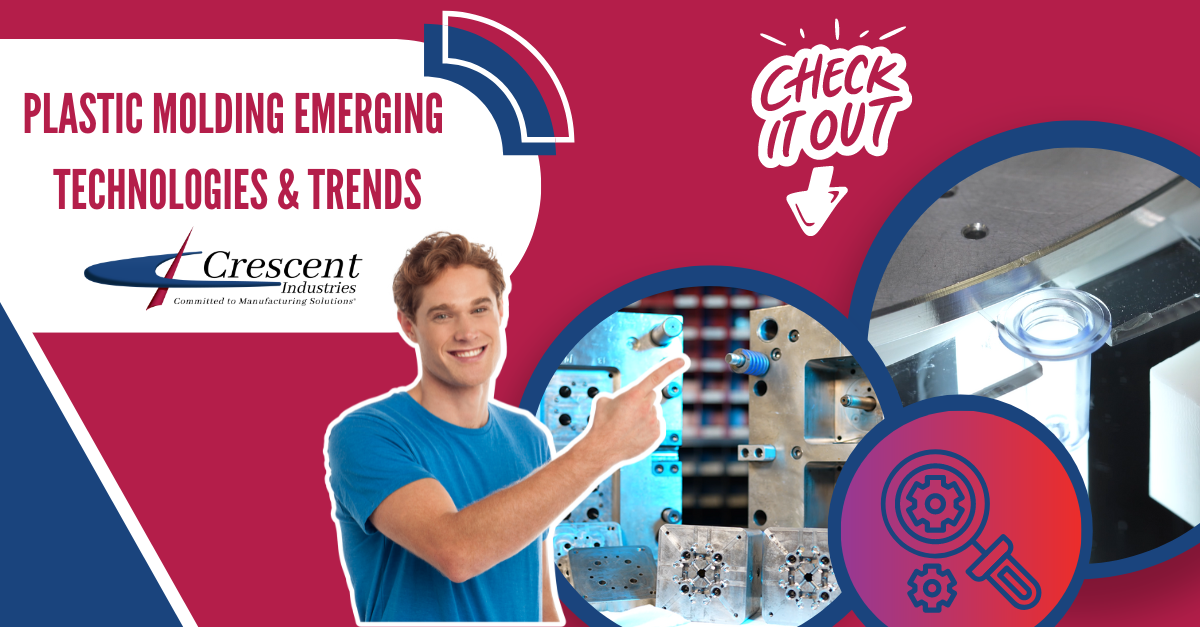Plastic injection molding is a manufacturing technique that has become the backbone of many production industries, from automotive and construction to healthcare, pharmaceuticals, medical devices, military applications, and transportation. This is mainly due to the wide spectrum of products that are cost- and time-effective to produce using injection molding.
Understanding what injection molding is and how it works is crucial. In this manufacturing process, thermoplastics or polymers are used as resin pellets and melted to form plastic parts of various shapes, sizes, and designs.
In this article, we’re going to explain the technology of injection molding, delve into its historical origins, and illuminate some of the emerging trends that are set to revolutionize the parts manufacturing industry.
How Plastic Injection Molding Technology Has Changed Throughout the Years
First used in the 19th century, the technology of plastic resin injection molding has evolved drastically over the past decades, revolutionizing the manufacturing sector. The first ever injection molding machines were patented by the American inventor John Wesley Hyatt and his brother, Isaiah Hyatt. However, the machine was only capable of producing small, basic items with limited precision.
In the 1940s, James Watson Hendry started with previous designs and came up with screw injection molding. This approach not only significantly improved the end product’s quality but made the production process more time- and cost-effective. It worked by maintaining a consistent flow of molten plastic into the mold, resulting in fewer irregularities and defects due to mold cavities or air bubbles.
The subsequent decades saw a boom in parts manufacturing, including the introduction of Computer Numerical Control (CNC) machining technology in the 1970s, which helped in reusable mold design and manufacturing. At the same time, injection technology was becoming more automated and less labor-intensive, making it the go-to choice for manufacturers.
In the 21st century, the basic technology of injection molding is often combined with advanced robotics and Industry 4.0, pushing it toward smarter manufacturing. AI-driven optimization plays a role in the design and production processes of injection molding, ensuring maximum efficiency, quality, and sustainability.
Emerging Technologies and Trends in Plastic Injection Molding
Today, plastic injection molding is a staple in manufacturing, but it continues to grow and evolve to meet market needs and demands. Within this growth, several notable trends are setting the pace for the future of the industry.
Advanced Range of Materials in Injection Molding
One of the industry’s most transformative developments is a wide range of new plastic materials. Manufacturing facilities can now choose from thermoplastics with varying mechanical properties, including composition, color, transparency, resiliency, and flexibility.
The introduction of new materials makes plastic injection molding accessible to new industries. For example, dentistry requires medical devices that are made with high precision and accuracy. So whether it’s flexible thermoplastic polymers or temperature-resistant plastics, the expansion of materials is bound to drive evolution.
Automation in the Plastic Injection Molding Process
Automation has made its way into the plastic injection industry, leading to a great leap in production efficiency and manufacturing precision. Today, most large-scale injection machines are equipped with advanced robotics and automation systems that replace the human element.
Combined with AI-driven optimization, parts made using plastic injection can now be created in higher quantities and faster cycle times, both of which are critical factors for industries that rely on speed to market to maintain their competitive edge.
This is further bolstered by real-time monitoring and predictive maintenance, allowing industries that rely on speed-to-market to maintain their competitive edge in an increasingly dynamic market environment.
Industry 4.0 Production Systems
Industry 4.0, also known as the Fourth Industrial Revolution, refers to the digital transformation of the manufacturing industry using the Internet of Things (IoT) and robotics. Many plastic injection molding companies are making use of functions such as the integration of real-time processing, predictive maintenance, and advanced data analytics in cloud computing to control the various stages of the production process. This transformation doesn’t only minimize downtime, it also allows production to adapt quickly to meet market demands.
Partner With an Industry Leader for Your Plastic Injection Molding Needs
In a field as rapidly evolving as plastic injection molding, partnering with an industry leader is the way to stay ahead of the curve. At Crescent Industries, we’re a proud employee-owned and USA-based plastic injection molding company and manufacturing partner. Our advanced engineering knowledge lets us stay on top of the latest trends in the industry and their capacity to make changes in the market.
We’re experienced in serving a diverse range of markets in industries, including the medical, pharmaceutical, dental, defense, and OEM/industrial sectors. Reach out to us and learn more about our custom plastic injection molding technologies to see how we can help you transform your vision into high-quality, functional products.

